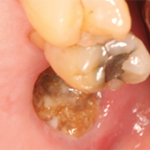Romosozumab is a monoclonal antibody that inhibits sclerostin, “with a dual effect of increasing bone formation and decreasing bone resorption,”7 Dr. Saag said. “Romosozumab is an inhibitor of bone formation and, thus, highly anabolic. When compared with teriparatide and alendronate, it’s really the most impressive in terms of increasing BMD.”8
When compared with alendronate, romosozumab also significantly reduced the risk of new vertebral fracture at 12 and 24 months.9
After receiving romosozumab, the patient was switched to denosumab. Dr. Saag said, “After we use an osteoanabolic drug, we should follow it with an antiresorptive. The pivotal study by Cosman et al. demonstrated the importance of this [approach].”7
‘Osteoporotic risk goes up after two years off therapy, & just how much depends on what bisphosphonate [the patient] took before. Some bisphosphonates are stickier to bone than others.’ —Dr. Saag
Case 3
A 48-year-old man with ulcerative colitis and spondyloarthritis on adalimumab, CKD with a GFR of 26, vertebral compression fracture on imaging and T-scores in the osteopenic range was referred for management. Although very low in the past, the patient’s 25-hydroxy vitamin D levels had normalized with supplementation. Calcium, phosphorous and 1,25-dihydroxyvitamin D levels were also normal. Parathyroid hormone and bone-specific alkaline phosphatase were slightly elevated. In the past, he was treated with several months of high-dose glucocorticoids.
Given the complexity of the case, Dr. Saag walked us through his thought process. The differential diagnosis included glucocorticoid-induced osteoporosis, metabolic bone disease due to CKD and vitamin D malabsorption with possible secondary hyperparathyroidism.
When it came to therapy, Dr. Saag said, “I wasn’t sure any of our drugs were good options, or that he even had osteoporosis. About 15% of men have evidence of vertebral compression fractures on imaging prior to the age of 50—so this may not have been an osteoporotic fracture after all. And for him, I was particularly worried about adynamic bone disease, which is a contraindication to antiresorptives.”
Adynamic bone disease is a type of renal osteodystrophy characterized by low or absent bone turnover in the context of a marked reduction in both osteoblast and osteoclast numbers. Bone biopsy remains the gold standard for diagnosis.
For this patient, Dr. Saag opted not to treat for osteoporosis. Instead, he recommended maintaining adequate vitamin D levels, monitoring for hyperparathyroidism and consideration of a bone biopsy.
Summary
The treatment of osteoporosis includes more than just bisphosphonates these days, and that’s a good thing. But careful consideration of a patient’s comorbidities—as well as the risks and benefits of continuing and discontinuing therapy—are paramount when it comes to protecting our patients from fractures.=

